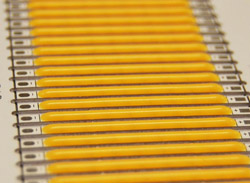UK-based Plessey has launched its range of LED filaments, manufactured with the firm's MaGIC (Manufactured on GaN-on-Si I/C) gallium nitride on silicon LEDs. The filaments are designed for the surging filament bulb market, where these replacement lamps have far better performance but still maintain the physical appearance of incandescent lamps.

Picture: Plessey's LED filaments.
Plessey says that its chip-on-board (COB) LED filaments create the same amount of light while consuming less energy and offering longer life than a traditional tungsten incandescent light bulb.
The LED filaments are designed with unique terminations so that they can be handled and spot welded by existing high-volume fully automated glass lamp manufacturing lines. In addition, Plessey has incorporated a bespoke approach to controlling the current and forward voltage (Vf) of the filaments when they are driven in a bridge configuration.

Picture: An LED filament bulb.
"We have taken our existing chip-scale packaging [CSP] technology, also used for our dotLEDs, into a revised format for the filament," says chief technology officer Dr Keith Strickland. "Not only do we have an improvement in terms of manufacturability with GaN-on-silicon and enhanced the power control for filament resistors, but Plessey will also be incorporating other active and passive electronic components for chip-on-board and chip-scale packaging solutions in the next generation of filaments," he adds. "Thermal performance and customization are key to our filament product portfolio, and Plessey remains committed to bring to market unique LED products through our integrated approach to solid-state lighting applications."
The PLF series of filaments come in a variety of lengths, light output and correlated color temperatures (CCT), from very warm 2200K to 6500K.





